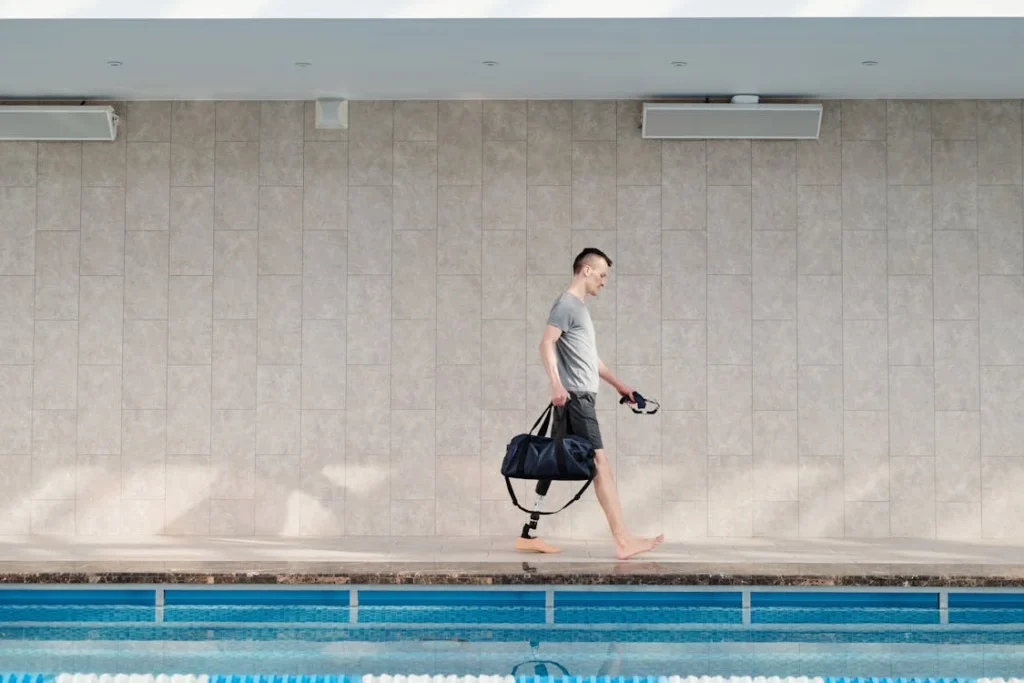Walking with a prosthetic leg changes how your body moves. At first, it might feel strange. Your balance may be off, and your posture may not feel natural. That’s okay. Every person who begins walking with a prosthesis goes through this phase. It’s part of the learning process. The good news is, with the right habits and a bit of practice, you can improve your balance and posture. This leads to safer walking, better comfort, and more confidence every step of the way.
At Robobionics, we’ve helped people all over India and beyond take their first steps with a prosthesis. We know that balance isn’t just about standing still, and posture isn’t just about looking straight. They work together, quietly in the background, to help you move freely and safely.
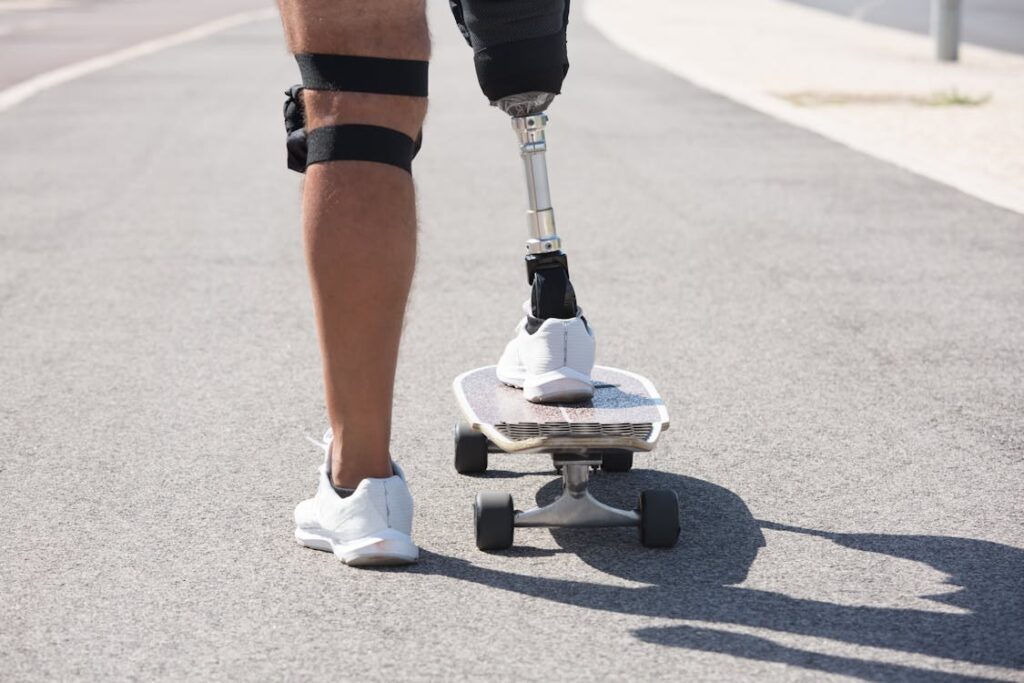
Why Balance and Posture Matter with a Prosthetic
When you walk, your whole body works as one. Your feet, legs, hips, back, and even your arms help keep you steady. But when one leg is replaced with a prosthesis, the body has to adjust. The natural balance changes.
The way your weight moves shifts. The muscles that used to help you stay upright now need to work differently. And your posture—the way you hold your body—often changes without you even noticing.
If your balance is off, it can lead to small missteps, tripping, or even falls. If your posture is poor, you may feel pain in your back, shoulders, or neck.
Over time, these small problems can become bigger ones. That’s why it’s so important to start paying attention to how you move, not just where you move.
Balance is More Than Standing Still
Balance is the ability to keep your body steady—whether you’re standing, walking, or turning. It relies on your muscles, joints, eyes, inner ears, and your brain all working together.
For people with both natural legs, balance happens almost without thinking. But with a prosthetic, your brain and body have to learn a new way of staying steady.
You might notice that you tend to lean more on your natural leg. This is very common. At first, the prosthetic side might feel weaker or less trustworthy.
But the more you avoid it, the more unbalanced your walk becomes. This uneven weight puts stress on your good leg and can make walking harder in the long run.
Working on balance doesn’t always mean doing big exercises. It starts with small, mindful movements. Standing still and feeling your weight evenly placed on both feet is one of the first steps.
Over time, this simple habit trains your body to trust the prosthesis more. Once that trust builds, your movements become smoother and more natural.
You may also find that balance is harder on uneven ground. Grass, sand, or sloped sidewalks all challenge your body in different ways.
Practicing in these real-life situations, once you’re ready, helps your brain learn how to adjust quickly and safely.
Posture Affects Everything
Posture is how you hold your body when you stand, sit, or move. Good posture helps your joints work smoothly, reduces muscle strain, and makes walking more efficient.
When your posture is off, your body has to work harder. You may not feel it right away, but over time, poor posture leads to fatigue and pain.
One of the biggest posture changes people experience after amputation is a forward lean. This often happens when you’re unsure about the prosthetic foot or trying to overcompensate for your balance.
While it might feel safer in the short term, leaning forward puts pressure on your back and throws off your natural gait.
Your shoulders may also shift without you noticing. Some people hike one shoulder up when they swing the prosthetic leg forward. Others tilt their torso to help move the leg. These small movements seem harmless but actually reduce stability and increase the risk of falling.
Correcting posture isn’t about standing stiffly. It’s about staying tall but relaxed. Imagine a string pulling the top of your head upward.
Keep your chest open, your shoulders back but soft, and your eyes looking forward. This position helps your body align properly and makes walking easier.
At Robobionics, we often tell our users that posture is the foundation. You can have a perfectly fitted prosthesis and strong muscles, but if your posture is off, everything else suffers.
That’s why we focus so much on building this habit from the beginning.
The Role of Core Strength in Stability
Your core is more than just your stomach muscles. It includes your back, pelvis, and the muscles deep inside that support your spine. These muscles are like your body’s natural stabilizers.
They keep you from tipping over when you take a step. They help you react quickly if you lose balance. And they support your posture during movement.
After an amputation, your core muscles may become weaker, especially if you spent time using a wheelchair or avoiding movement. Rebuilding this strength is key to walking safely with a prosthesis.
You don’t need to do intense workouts to strengthen your core. Simple activities like standing on one leg for a few seconds, practicing slow side-to-side shifts, or even sitting upright without leaning can activate these muscles. The goal is to build gentle, steady control.
Once your core is stronger, you’ll notice your balance improves naturally. Your posture becomes easier to maintain. And you’ll have more control in situations where the ground isn’t flat or where you need to turn quickly.
Making Balance and Posture Part of Everyday Life
Improving balance and posture doesn’t mean you have to spend hours doing exercises. In fact, some of the best improvements come from small changes in daily habits.
How you get out of bed, how you sit at the table, how you brush your teeth—these moments all train your body.
Start by paying attention when you stand. Are you leaning on one side? Try shifting until you feel equal weight on both legs. When you walk, do you keep your head up and look ahead? Or are you looking at your feet? Looking ahead improves your posture and makes your steps more confident.
Over time, these small habits become natural. Your body starts to remember the right positions. And as it does, walking feels less like a task and more like freedom.
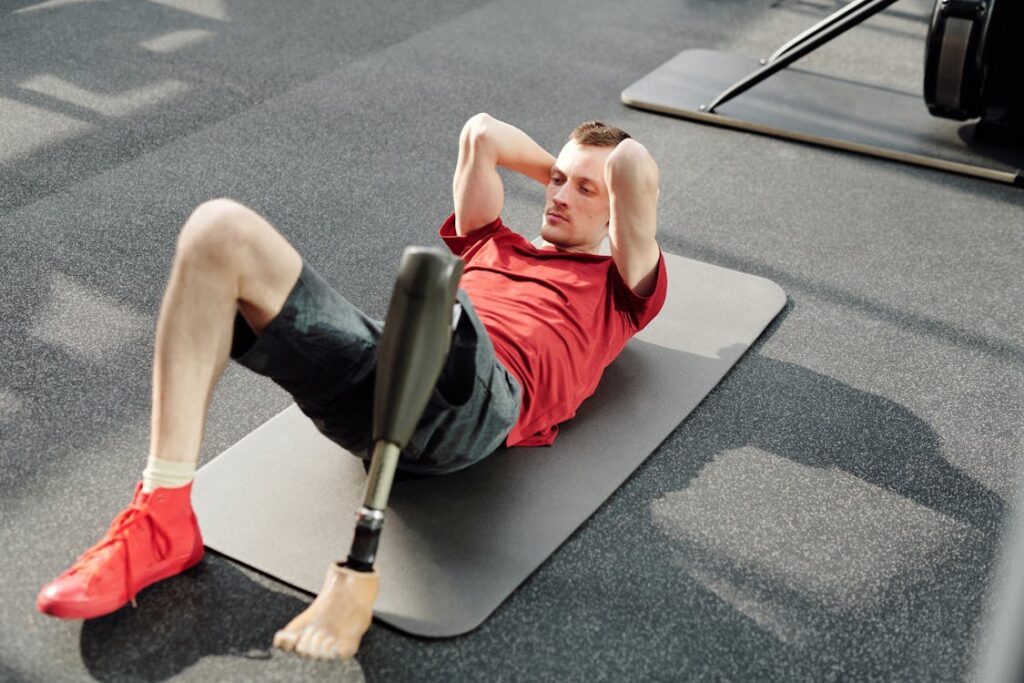
Training Your Body to Move with Confidence
When you start walking with a prosthetic leg, your body moves in a different way than it did before. This is completely natural. It takes time for your muscles, joints, and brain to adjust.
But with steady training, you can teach your body to move smoothly, with control and ease. One of the best ways to do this is by focusing on how you move, not just how far or fast you go.
Every step you take is a chance to improve your balance and posture. Whether you’re walking across a room or down the street, the way you move matters.
Think of each step as practice. With every repetition, your muscles get better at doing their job, your brain gets more confident, and your gait becomes more stable.
The Importance of Slow, Controlled Walking
In the beginning, it’s tempting to walk as quickly as possible. You may want to get from one place to another without thinking too much.
But walking too fast too soon often leads to bad habits. You may start dragging your prosthetic foot, locking your knee, or tilting your upper body to compensate for lack of control.
That’s why slow, controlled walking is so powerful. It helps your body relearn how to walk with purpose.
When you move slowly, you can feel what each part of your body is doing. Are your hips level? Are your steps the same length? Is your weight shifting evenly from side to side?
Walking in front of a mirror can help. Seeing your movements in real time allows you to make adjustments. Maybe you didn’t realize you were leaning.
Maybe your arm on one side isn’t swinging naturally. With this feedback, you can begin correcting these small details that make a big difference.
Practicing walking slowly isn’t a step backward—it’s a step toward long-term success. Once your balance and posture improve, your speed will increase naturally. But this time, you’ll be moving with strength and stability.
Learning to Trust the Prosthetic Side
One of the biggest emotional and physical challenges is learning to trust your prosthetic side. In the early days, you may feel nervous putting full weight on it.
You may favor your sound leg without even realizing it. But this imbalance not only affects your gait—it also prevents your prosthetic leg from becoming a true part of your movement.
To fix this, you have to start with simple exercises that teach your body to load weight evenly. Standing with both feet flat and gently swaying from side to side helps.
As you shift your weight to the prosthetic side, try to hold that position for a few seconds. It might feel shaky at first, but with repetition, your balance will improve.
Eventually, you’ll be able to place full trust in the prosthetic foot. You’ll stop thinking about every little movement, and your body will start working as a whole again.
This kind of balance gives you freedom—not just to walk, but to turn, climb, and explore your environment safely.
Navigating Different Surfaces with Balance and Posture
Life doesn’t happen only on smooth floors and flat sidewalks. You’ll face all kinds of surfaces—tiles, carpet, gravel, ramps, and maybe even wet or uneven ground.
Each of these surfaces challenges your balance in different ways. That’s why it’s important to train on them gradually and carefully, once your basic posture and balance are steady.
When walking on softer surfaces like grass or sand, your prosthetic foot won’t push off the ground as firmly. This can make your step feel less powerful or stable.
To handle this, keep your posture upright and take slightly shorter steps. Engage your core so your upper body stays centered even when the ground feels soft or unsteady.
When walking downhill, there’s a natural tendency to lean backward out of fear. But leaning back actually reduces your control. Instead, lean slightly forward from the hips and keep your knees slightly bent. This keeps your body aligned with the slope and allows your prosthesis to move naturally with gravity.
Slippery floors, like polished tiles or wet ground, require extra caution. Make sure your prosthetic foot is placed fully on the ground with each step.
Avoid quick turns or sudden stops. Keep your eyes up and your movements steady. Practicing good posture and balance ahead of time helps you move with more control, even in these tricky situations.
These real-world surfaces are not to be feared—they are opportunities to apply everything you’ve been working on. With every step, you are training your body to respond to new challenges with calm and control.
Using the Arms and Upper Body to Improve Balance
Your arms play a surprisingly big role in balance and posture. When you walk, your arms naturally swing opposite to your legs. This counter-swing helps you stay upright, keeps your torso stable, and makes your gait look and feel more natural.
But after getting a prosthesis, many users stop swinging their arms. They may feel tense or unsure. Sometimes, they even hold their arms stiffly or close to their body for balance.
While this feels safe in the moment, it actually makes walking harder in the long run.
Letting your arms swing naturally helps restore the rhythm of your walk. It spreads movement across your whole body, instead of loading it all into your legs and hips. Over time, your gait becomes smoother and more efficient.
Also, your upper back and shoulders support good posture. If your shoulders are rounded or uneven, it affects the curve of your spine and the alignment of your hips. Keeping your shoulders level and relaxed helps the rest of your body follow suit.
If you notice your shoulders rising or your upper body stiffening as you walk, take a breath and gently reset. Drop your shoulders down and back, open your chest, and look forward. These small adjustments help you move more freely and safely.
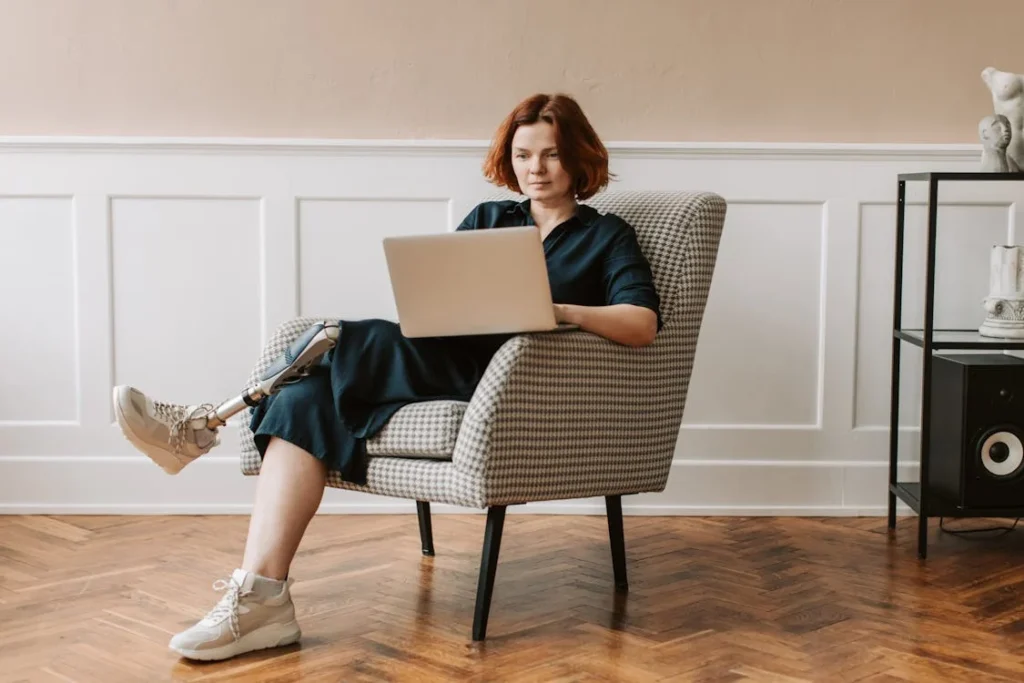
Building Daily Habits That Reinforce Good Posture and Balance
Safe walking with a prosthetic is not something you only practice during therapy. It’s something that needs to become part of your everyday routine.
The way you sit, stand, reach, turn, and even rest throughout the day affects how you walk. These little habits, repeated every day, can either support your progress or quietly work against it.
To improve balance and posture long-term, you need to bring awareness into your normal routine. You don’t have to turn daily life into a workout. What matters most is how you do things.
Even the simplest actions—getting out of a chair, standing at the sink, walking to another room—can be powerful training moments if done with intention.
Standing Up and Sitting Down With Control
One of the most common activities we all do is getting up and sitting down. But for prosthetic users, this movement is especially important.
Done poorly, it creates imbalances in muscle use and posture. Done well, it strengthens your core, improves your balance, and teaches you to use your prosthetic leg more fully.
When standing up, avoid pushing only through your sound leg. Try to use both legs evenly. Place your feet flat on the ground, keep your chest upright, and lean forward from the hips.
Press down through both feet and use your hands only if needed for support. This action engages your hips and core and reminds your prosthetic side that it plays an active role.
When sitting down, resist the urge to fall back into the chair. Control the movement. Keep your weight centered.
Lower yourself slowly, using your core and leg muscles to guide you. This not only protects your joints but also builds strength in the muscles you need for walking.
Over time, these simple transitions become opportunities to reinforce balance. You do them many times a day—why not make them count?
Turning, Reaching, and Daily Movement Patterns
Another overlooked area is how we turn and reach for things. People often twist their bodies quickly, especially when they’re in a rush or distracted. But twisting without balance can throw off your posture and lead to falls.
Instead, practice turning in small, controlled steps. Pivot your feet gradually instead of twisting from the waist. Keep your weight centered and your upper body stable. This protects your spine and keeps your gait pattern healthy.
When reaching for items, whether on a shelf or a countertop, pay attention to your base. Keep both feet planted if possible.
If you need to stretch up, tighten your core muscles slightly to protect your balance. These small moments help train your brain to stay centered, even during movement.
The more you do these everyday actions with awareness, the more natural good balance and posture become.
Using Mirrors, Feedback, and Body Awareness
Sometimes, the hardest part of improving posture is knowing what it looks and feels like. Your body might get used to poor alignment without you realizing it. This is where mirrors and feedback become helpful tools.
Try standing in front of a mirror once a day. Look at your shoulders—are they level? Are your hips even? Are you leaning more to one side?
Take a few slow steps and watch how your body moves. Don’t worry about being perfect. Just notice what you see and make small corrections.
If you live with someone or have access to a therapist, ask them to observe your posture from behind or the side. Often, others can see what we miss. A quick reminder—“you’re leaning left,” or “lift your head a bit”—can help train your body to find better alignment.
Developing body awareness is also key. Try checking in with yourself a few times a day. Ask: How am I standing? Where is my weight? Are my shoulders relaxed? These questions pull your focus back to posture and balance, even during a busy day.
This awareness creates a long-term shift. It helps you catch imbalances before they turn into pain or bad habits.
Practicing Balance Without Fear
Fear is one of the biggest barriers to building balance. After an amputation, it’s normal to feel nervous about falling. That fear often leads to stiff, cautious movements, which ironically make falls more likely. True balance requires fluid movement—and fluidity only comes when you start to trust your body again.
Start with very small challenges. Stand near a counter or sturdy table where you feel safe. Try gently shifting your weight side to side. Then try lifting your sound foot off the ground for a few seconds. Focus on keeping your hips level and your shoulders steady.
You don’t need to balance for long. Even five seconds is a success. The key is consistency. As your confidence grows, you can add more movement—reaching while standing, stepping in different directions, or balancing on your prosthetic leg.
The more you practice, the more your brain learns that you’re safe and capable. That belief is just as important as muscle strength.
Choosing the Right Environment to Support Balance
Your home and surroundings also play a role in your balance. Make sure your walking areas are clear and well-lit. Remove loose rugs, cords, or anything that might trip you up. A safe environment allows you to focus on your posture and balance without distraction.
Try to walk in spaces where you feel comfortable and not rushed. Stress and hurry make balance harder. When you’re calm, your body moves better. So give yourself time. Let your movements be steady and thoughtful.
If you have access to a quiet garden, a terrace, or even a large room at home, use it as a walking zone. These safe, familiar places are perfect for practicing good posture and improving your step quality.
As you progress, challenge yourself with new surfaces like grass or ramps—always with support nearby. These conditions force your body to adjust, which strengthens your balance even more.
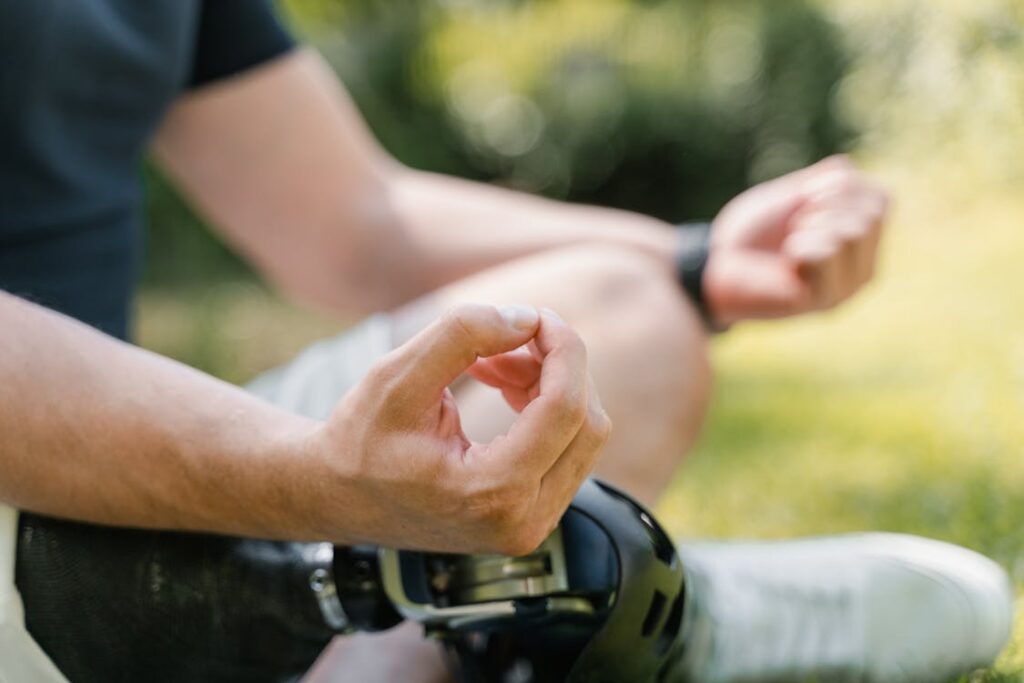
Strengthening the Mind-Body Connection
Walking safely with a prosthetic leg isn’t just about muscles, alignment, or even practice. It’s also about reconnecting your mind to your body. After limb loss, many people experience a shift in how they think about movement.
You’re no longer just walking—you’re aware of every step, every shift, every pause. This awareness is powerful, but it can also be tiring if your brain and body aren’t working in sync.
To improve posture and balance, it helps to build a stronger mind-body connection. That means slowing down, tuning in, and truly feeling your movements as you walk.
It means becoming more conscious of your center of gravity, your weight shifts, your arm swing, and how each part of your body supports the others.
Mindful walking is one way to do this. It’s not about how far you go, but how present you are while walking. Instead of thinking about your destination, focus on the present moment.
Feel your heel touch the ground. Feel your body weight shift over your foot. Feel the toe push off and the leg swing through.
Each part of your walking pattern becomes clearer with practice. And as your awareness improves, your movements become smoother. You start walking with intention, not just reaction.
Breathing and Posture: An Overlooked Connection
Another key part of the mind-body connection is breathing. It sounds simple, but the way you breathe affects the way you move.
Shallow, tight breathing often causes the shoulders to hunch forward. This leads to stiffness in the chest and upper back, which affects posture and can even make balance harder.
Deep, slow breathing relaxes your muscles. It allows your chest to open and your spine to align naturally. When you breathe fully, your core activates gently to support your body’s movement. This helps with upright posture and stable walking.
Try taking a few deep breaths before each walk. Inhale through your nose, letting your ribcage expand. Exhale slowly through your mouth. As you breathe, notice how your body feels.
Are your shoulders relaxed? Is your neck soft? Do you feel tall and balanced? Breathing acts like a reset button, allowing your body to settle into better posture before you take that first step.
During walking, try to keep your breathing even and relaxed. Avoid holding your breath or tensing your shoulders. The more relaxed your upper body, the easier it is for your lower body to move naturally.
When to Ask for Help and What to Expect
Even with practice and effort, there may be times when balance or posture feels off. You might notice discomfort in your back, pain in your hips, or tension in your shoulders that wasn’t there before.
These signs should never be ignored. They’re your body’s way of asking for help.
Reaching out to a physiotherapist, prosthetist, or rehabilitation specialist is not a setback—it’s a smart step forward.
These professionals can analyze your gait, posture, and alignment in ways you can’t always do on your own. They can spot subtle shifts, catch early signs of compensation, and offer targeted exercises or prosthetic adjustments.
Sometimes, the issue is as simple as changing your walking pattern. Other times, a small change in your socket or foot can bring major relief. The key is to listen to your body and act earl
y. The longer you walk with poor posture or balance, the harder it is to correct later.
At Robobionics, we always tell our users: you are not alone in this journey. Safe, confident walking is not something you figure out overnight. It’s a process, and it’s okay to ask questions, make changes, and explore what works best for your body.
Preventing Long-Term Problems with Good Habits
Fixing posture and balance isn’t just about walking better now—it’s about protecting your health in the future. When posture is poor, it places extra strain on your joints.
Over time, this can lead to pain in your knees, hips, back, or even your neck. These aches don’t always show up right away. They build slowly, often going unnoticed until they interfere with your daily life.
By building good habits now, you prevent many of these long-term issues. Even small adjustments—like standing evenly on both legs, keeping your head up when walking, or engaging your core during movement—can protect your body from unnecessary wear and tear.
Another benefit is energy efficiency. Walking with poor posture uses more energy. You may get tired faster, and everyday tasks may feel harder. With better posture and balance, you conserve energy. Your steps become more fluid, and you can walk farther without feeling drained.
This also supports your independence. When your walking feels safe and comfortable, you’re more likely to stay active, socialize, and explore new places.
You’re not held back by fear of falling or frustration from pain. You move through the world with confidence.
The Emotional Strength Gained Through Balance
One of the most rewarding outcomes of improving balance and posture isn’t just physical—it’s emotional. There’s a deep sense of confidence that comes from knowing you can walk tall, steady, and strong.
Each step you take with control builds self-belief. You stop worrying about how you look or whether others notice your gait. You stop second-guessing each movement. You start focusing on where you’re going, not how you’re getting there.
This emotional strength spreads into every part of your life. It gives you courage to try new things, visit new places, or return to old routines you once avoided.
It shows up in your posture—your head held high, your shoulders open, your back straight—not just because it helps your walk, but because it reflects your inner confidence.
And when setbacks happen—as they sometimes do—you’ll have the resilience to keep going. You’ll know that balance and posture aren’t fixed points.
They’re living, breathing parts of your body that can be improved, adjusted, and restored.
Every step you take with awareness and care is an investment in your long-term well-being. You’re not just walking—you’re rebuilding the foundation for a safer, stronger, and more confident future.
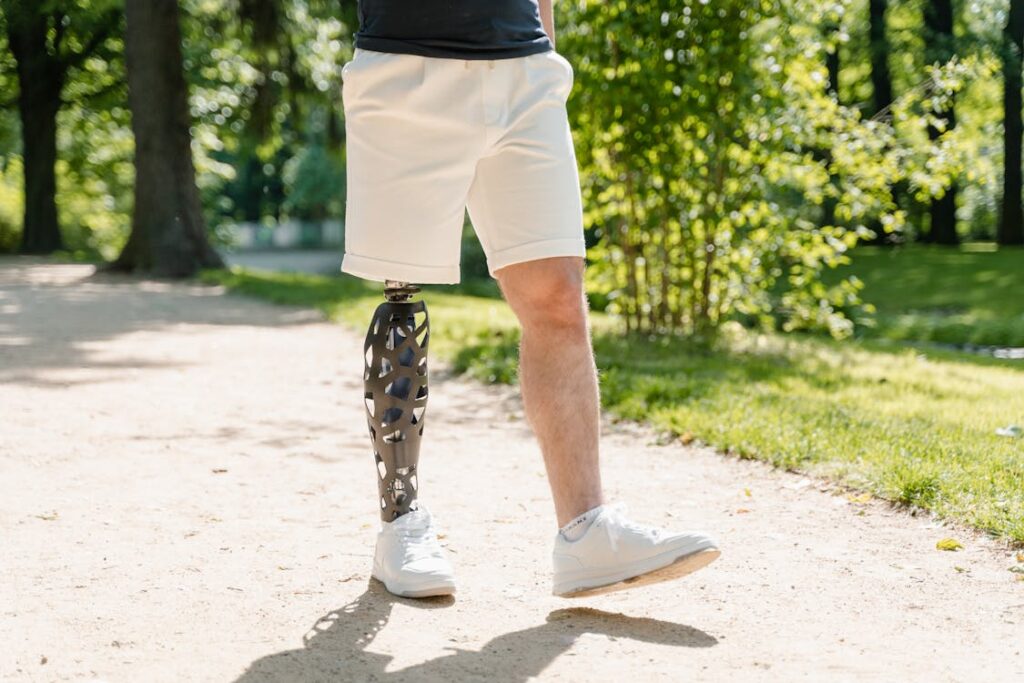
Footwear and Its Role in Balance and Posture for Prosthetic Users
When talking about balance and posture with a prosthetic leg, one element is often ignored—but it can make or break your stability: your footwear. The shoes you wear every day directly affect how your body stands, walks, and maintains alignment.
They influence how your weight is distributed, how your prosthesis responds to the ground, and how confidently you move through your day.
A good pair of shoes doesn’t just support your feet—it supports your entire gait.
The Connection Between Shoes and Stability
For someone using a prosthetic leg, the foot and ankle are no longer powered by muscles and joints. Instead, the prosthetic foot relies on mechanics and materials to simulate movement.
This means your shoes become part of that system. They affect how your prosthesis performs during each step—from heel strike to toe-off.
If your shoes are too soft, your prosthetic side may sink too much during each step, throwing off your balance. If they’re too stiff or high, they can change the angle of your alignment and cause instability in your hips or back.
Small shifts in sole height—even a few millimeters—can change how your prosthetic leg interacts with the ground.
That’s why consistency in your footwear is important. When you change shoes often, especially shoes with different heel heights or materials, your posture and gait may suffer. Your body constantly has to re-adapt, which makes smooth, confident walking harder to maintain.
At Robobionics, we often advise new users to choose one or two pairs of well-fitting, supportive shoes and stick with them during the early phases of rehabilitation.
Once your gait is steady, you can explore other footwear—always with caution.
Features to Look for in Everyday Shoes
When selecting shoes, think about stability first. A flat, supportive sole helps keep your weight evenly distributed.
Shoes with a firm heel counter (the back part of the shoe that wraps around your heel) provide better control and keep your ankle from wobbling.
A snug but not tight fit is key. Shoes that are too loose can lead to sliding, which disrupts balance. Shoes that are too tight may cause discomfort and lead you to shift your weight awkwardly. Aim for a fit that supports the foot firmly but allows natural movement.
Heel height is another critical factor. Even a slightly raised heel can shift your posture forward, putting strain on your back and knees.
Ideally, choose shoes with minimal heel elevation—just enough to support natural walking without changing your alignment.
Shoes should also be lightweight. Heavy shoes increase the energy needed to walk, especially for new prosthetic users. Lightweight shoes reduce fatigue and make balance easier to maintain throughout the day.
The bottom of the shoe matters too. Look for slip-resistant soles with good grip, especially if you walk on tile, marble, or smooth flooring. A good tread pattern helps prevent slips without making the shoe feel too “sticky” during normal walking.
Adapting Shoes for Prosthetic Alignment
In some cases, your prosthetist may need to adjust your prosthetic alignment based on the type of shoes you wear most often.
This is especially true if you choose shoes with slightly thicker or higher soles. The goal is to keep your walking pattern smooth and balanced—even with footwear variations.
Some users benefit from wearing shoes with removable insoles. This makes it easier to fine-tune the internal space of the shoe to fit your residual limb length or the foot height of the prosthesis.
It also gives your prosthetist more flexibility in adjusting your setup without requiring major changes to the prosthesis itself.
If you enjoy activities like hiking, gardening, or light sports, specialty shoes with added ankle support and shock absorption can help reduce strain on your body.
Just make sure to test these shoes gradually. A shoe that works great for a few minutes might feel very different after an hour of use.
Managing Footwear on the Sound Side
It’s important to also consider your sound leg. Many people focus only on the prosthetic side, but the natural foot is under new demands as well. It’s often bearing more weight, absorbing more shock, and doing more work to stabilize your gait.
Wearing the right shoe on your sound side helps distribute pressure more evenly and prevents injury. Over time, if the natural foot is not supported properly, it can lead to pain in the arch, ankle, or knee. Good footwear can help balance your gait and reduce these risks.
If needed, your therapist or prosthetist might recommend a custom insole or orthotic insert for your sound foot.
These devices provide extra support and can improve overall alignment, especially if you’ve developed an uneven walking pattern.
Practical Tips for Everyday Shoe Use
Once you find shoes that work well, take care of them. Worn-out soles or uneven treads can undo your progress. Replace shoes regularly if the grip wears down or the inside starts to feel uneven. Your safety depends on steady support every day.
Try to break in new shoes slowly. Even if the shoe is the same brand or model as your current pair, materials change slightly between batches.
Wear them at home first, then for short walks, before using them for a full day. Let your body adapt without rushing.
And always keep a reliable, comfortable pair nearby for times when your body feels tired or unsteady. On days when your balance feels off, going back to a trusted shoe can help restore confidence and prevent falls.

Nighttime Habits and Restorative Practices to Support Balance and Posture
We often focus on what happens during the day—exercises, walking techniques, alignment, and routines. But what you do at night is just as important for posture and balance, especially if you’re a prosthetic user.
The body heals, recharges, and resets while you rest. Sleep, nighttime posture, and simple end-of-day habits can make a big difference in how steady and comfortable you feel when walking the next morning.
Balance isn’t just trained—it’s also restored. And that restoration happens while you sleep.
How Sleep Quality Affects Physical Control
When you don’t sleep well, your body struggles to function properly. You might feel groggy, your reaction time slows, and your ability to control movement declines.
This makes walking less stable and increases your risk of falls. Poor sleep also affects muscle recovery. If your muscles don’t fully rest and repair at night, they feel tired and tight during the day—two things that can ruin good posture.
Good balance requires quick adjustments. When you’re fully rested, your brain can respond faster to small changes in surface, slope, or position.
When you’re tired, those responses are slower and less accurate. A small misstep becomes a near-fall, and what should feel like a smooth walk turns into a cautious shuffle.
Creating a consistent sleep schedule and wind-down routine helps your nervous system reset. It reduces tension, improves joint alignment, and prepares your body to walk more confidently the next day.
Sleep Position and Postural Health
Your sleeping position directly affects how your spine, hips, and neck align. Over time, poor sleep posture can cause muscles to tighten unevenly, which affects how you stand and walk.
For prosthetic users, this is even more important because one side of the body already experiences unique mechanical stress.
If you sleep on your side, try to keep your spine neutral. Avoid curling too much or twisting your torso.
A pillow between your knees can help keep your hips level and prevent the prosthetic side from rotating awkwardly. This reduces strain on your lower back and helps your pelvis stay aligned.
If you sleep on your back, use a small pillow under your knees to ease pressure on your lower spine. Keep your head supported but not raised too high, as that can tilt your neck forward and affect posture the next day.
Be mindful of how your prosthesis is positioned if you wear it to bed—which is rare but sometimes medically necessary. Most users remove the prosthesis at night, which allows the limb to breathe and relax.
However, how you support the residual limb while sleeping is important. Use a soft cushion if needed, and avoid sleeping with your limb hanging off the bed or twisted to one side.
Stretching Before Bed to Reset Your Body
Adding a gentle stretch routine before bed can improve flexibility and posture overnight. It relaxes tight muscles, calms the nervous system, and helps your joints settle into a neutral position for sleep.
You don’t need to do anything intense. A few simple movements, done slowly, can help:
- Gently stretch your lower back by lying on your back and slowly pulling your knees toward your chest one at a time.
- Open up the chest by standing with your arms behind your back, interlacing your fingers, and lifting gently to stretch the shoulders and upper spine.
- Stretch your hamstrings by placing one foot on a low surface, keeping your back straight, and leaning forward just enough to feel a gentle pull.
These calming movements release tension built up from walking, standing, or sitting during the day. When your muscles are relaxed before sleep, your posture in the morning will be stronger and more natural.
Evening Check-Ins: A Habit for Awareness
Before going to bed, take two minutes to check in with your body. Ask yourself:
- Did I feel balanced today?
- Was I leaning more on one side?
- Was there any pain, stiffness, or tension?
- Did I feel strong when walking?
This small habit builds body awareness. It helps you notice changes before they turn into problems. If you felt off balance today, you can plan a few gentle stretches or a balance drill tomorrow.
If you felt tension in your shoulders, you might remind yourself to relax your arms during tomorrow’s walk.
This reflection turns your routine into a cycle of learning, adjusting, and improving.
Rest Is Progress
Rest is not time off from progress—it’s part of progress. Without quality sleep and intentional rest, all the training and posture work during the day can unravel.
Muscles that don’t rest don’t grow stronger. A nervous system that doesn’t relax can’t respond well during movement.
By treating nighttime as part of your gait training—not separate from it—you give your body the full support it needs to walk with control, posture, and ease.
Conclusion
Safe walking with a prosthetic is not just about steps—it’s about awareness, balance, and posture working together every day. From how you stand and sit, to the shoes you wear and the way you sleep, each part of your routine shapes the way you move. With mindful practice, simple habits, and the right support, you can build strength, regain confidence, and move through life with more control.
At Robobionics, we believe that every person deserves to walk not just safely, but proudly. Whether you’re just starting out or refining your stride, remember that progress isn’t about speed—it’s about moving with purpose, stability, and trust in your body. Every step matters. And with care, consistency, and courage, those steps will take you exactly where you need to go.



